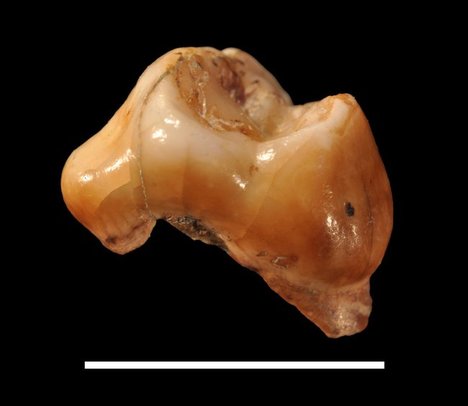 “One of the infant teeth (a deciduous left upper first molar) whose age had been underestimated. The white bar is 1 centimeter in length.” Source of caption and photo: online version of the NYT article quoted and cited below.
“One of the infant teeth (a deciduous left upper first molar) whose age had been underestimated. The white bar is 1 centimeter in length.” Source of caption and photo: online version of the NYT article quoted and cited below.
(p. A4) The fossils seemed hardly worth a second look. The one from England was only a piece of jawbone with three teeth, and the other, from southern Italy, was nothing more than two infant teeth. But scientists went ahead, re-examining them with refined techniques, and found that one specimen’s age had previously been significantly underestimated and that the other’s dating and identity had been misinterpreted.
They had in fact discovered the oldest known skeletal remains of anatomically modern humans in the whole of Europe, two international research teams reported Wednesday.
The scientists who made the discovery and others who study human origins say they expect the findings to reignite debate over the relative capabilities of the immigrant modern humans and the indigenous Neanderthals, their closest hominid relatives; the extent of their interactions; and perhaps the reasons behind the Neanderthal extinction. The findings have already prompted speculation that the Homo sapiens migrations into Europe may have come in at least two separate waves, rather than just one.
In tests conducted at the Oxford Radiocarbon Accelerator Unit in England, the baby teeth from Italy were dated at 43,000 to 45,000 years old. Other analysis showed the teeth to be those of a modern human, not a Neanderthal, as previously thought when the fossil was unearthed in 1964 from the Grotta del Cavallo.
For the full story, see:
JOHN NOBLE WILFORD. “Fossil Teeth Put Humans in Europe Earlier Than Thought.” The New York Times (Thur., November 3, 2011): A4.
(Note: the online version of the article is dated November 2, 2011.)
